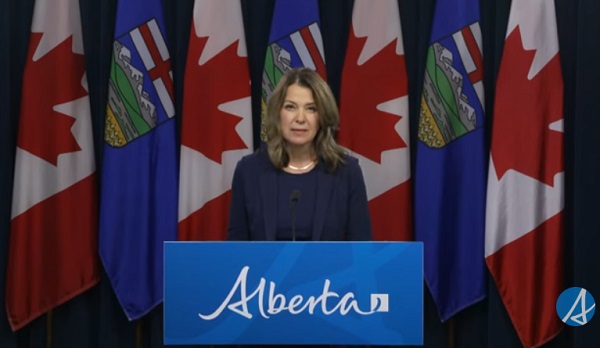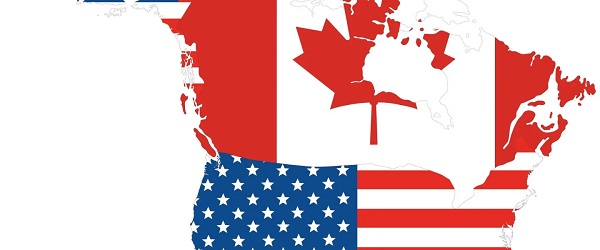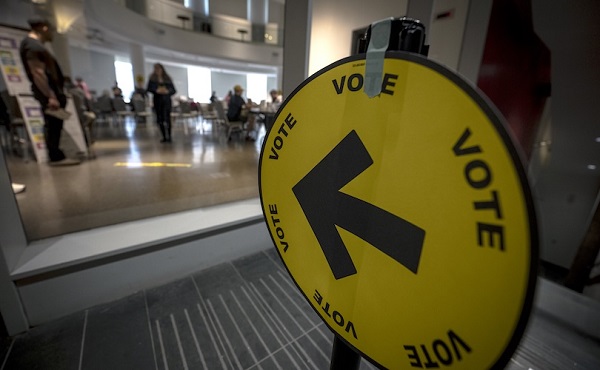Alberta
Masks to be mandatory in Alberta schools – Update on back to school plan

From the Province of Alberta
School health measures now include mandatory masks
As part of a number of new school safety measures to combat COVID-19, mask use for Grade 4 to 12 students, and all school staff, will be mandatory when school returns for the 2020-21 year.
While mandatory mask use is for students in Grades 4 to 12 and all staff, all students and staff in public, separate, Francophone, charter and independent schools will receive two reusable masks from Alberta’s government. More than 1.6 million masks will be distributed to 740,000 students and 90,000 staff. Additional single-use masks will be available at schools, if required.
Mask use will be mandatory for staff and teachers in all settings where physical distancing cannot be maintained. Students will be required to wear them in all shared and common areas such as hallways and on buses. Exemptions will be made for students and staff who are unable to wear a mask due to medical or other needs.
Mask use for kindergarten to Grade 3 students will continue to be optional. Mask use for younger children is a challenge due to difficulties with proper fit and compliance. In addition, evidence shows that children under 10 may be less likely than older children or adults to transmit COVID-19.
“The safety of our staff and students continues to be my number 1 priority. Since cancelling in-person classes in March and developing our school re-entry plan, we have been clear that we would continue to adapt our guidelines as necessary based on current medical advice. These new safety measures will help prevent the spread of COVID-19 in our schools, and we will continue to work with our school authorities to ensure they are equipped for a successful start to the school year.”
“After reviewing the emerging evidence, it is clear that masks can play an important role in limiting the spread of COVID-19. I am not making this updated recommendation lightly, but acting on the best current evidence available. While masks are important, I want to stress that they are only one of the many public health measures in place to limit the spread of COVID-19 and protect the health of students, staff and families.”
“CASS’ board of directors appreciates the government’s commitment to adapting Alberta’s health guidelines as new medical information becomes available and for ensuring school divisions are receiving the protective equipment they need for a successful transition back to school. This announcement clearly demonstrates Alberta Education’s willingness to take the necessary steps to support the safety of staff and students. We appreciate their continued collaboration and support as we approach the beginning of a new school year.”
Alberta’s government remains committed to adjusting the school re-entry guidelines based on current medical advice. The chief medical officer of health has been studying the evidence around masking in schools, and this decision is a direct result of evolving medical advice.
Face shields
School staff will receive one reusable face shield for their use in the schools. Shield use is at the discretion of the individual staff member. Plastic face shields can help reduce exposure but are not equivalent to masks. A mask must still be worn while wearing a face shield.
Hand sanitizer
About 466,000 litres of hand sanitizer will be distributed between all school authorities. The specific volume provided to an individual school authority will be based on student population.
Thermometers
Each school will receive two contactless thermometers to assist with managing student and staff health. Thermometer use will be at the discretion of the school authority.
Staff testing
Alberta Health and Alberta Health Services are working hard to expand testing capacity and reduce turnaround times for testing, including in-school staff, teachers and students, so that anyone with symptoms or close contacts of cases can be rapidly tested and receive test results promptly.
All supplies will be distributed to school authorities by the beginning of the 2020-21 school year. Authorities will then distribute to individual schools, staff and/or students based on the needs of their own communities.
Provincial health guidance for a safe return to school will continue to evolve as necessary to reflect the latest evidence on the nature of the COVID-19 pandemic.
Individual school authorities are developing return-to-school plans that meet the needs of their own communities. These plans are based on direction provided under the provincial school re-entry plan, and supporting health guidance documents.
Alberta’s Recovery Plan is a bold, ambitious long-term strategy to build, diversify, and create tens of thousands of jobs now. By building schools, roads and other core infrastructure we are benefiting our communities. By diversifying our economy and attracting investment with Canada’s most competitive tax environment, we are putting Alberta on a path for a generation of growth. Alberta came together to save lives by flattening the curve and now we must do the same to save livelihoods, grow and thrive.
Quick facts
- Alberta’s government announced students and staff would return to school under scenario 1 – near-normal daily operations with health measures – on July 21.
- School authorities are required to be prepared to move between the three scenarios outlined in the provincial school re-entry plan. Changes to scenarios will be determined by Alberta Education.
Alberta
Premier Smith moves to protect Alberta in International Agreements

Protecting Alberta’s jurisdiction
The International Agreements Act ensures Alberta’s jurisdiction is protected and decisions that shape our future are made right here at home.
This legislation draws a clear line: international agreements that touch on provincial areas of jurisdiction must be debated and passed into law in Alberta.
Alberta, not Ottawa, will decide how international agreements that affect provincial matters apply in the province.
“As we return to the legislature, our government is focused on delivering on the mandate Albertans gave us in 2023 to stand up for this province, protect our freedoms and chart our path forward. We will defend our constitutional rights, protect our province’s interests and make sure decisions that affect Albertans are made by Albertans. The federal government stands at a crossroads. Work with us, and we’ll get things done. Overstep, and Alberta will stand its ground.”
While the federal government has the power to enter into international agreements on behalf of Canada, it does not have the legal authority to impose its terms on provinces. The International Agreements Act reinforces that principle, ensuring Alberta is not bound by obligations negotiated in Ottawa that do not align with provincial priorities.
Bill 1 was introduced by Premier Danielle Smith following the fall 2025 speech from the throne as part of Alberta’s commitment to defend its sovereignty within a united Canada.
Key facts
- If passed, the International Agreements Act will replace the International Trade and Investment Agreements Act.
- The new legislation would expand its scope beyond trade and investment to include all areas of provincial jurisdiction.
- Currently, there is no formal agreement or requirement for the federal government to consult provinces when negotiating international treaties.
- Quebec’s Act respecting the exercise of the fundamental rights and prerogatives of the Québec people and the Québec State came into force in 2000.
- International agreements do not apply in Quebec unless approved by the national assembly or the provincial government.
- Quebec must give clear consent before any international agreement takes effect.
Related information
Agriculture
From Underdog to Top Broodmare

WATCH From Underdog to Top Broodmare (video)
Executive Producers Jeff Robillard (Horse Racing Alberta) and Mike Little (Shinelight Entertainment)
What began as an underdog story became a legacy of excellence. Crackers Hot Shot didn’t just race — she paved the way for future generations, and in doing so became one of the most influential producers the province has known.
The extraordinary journey of Crackers Hot Shot — once overlooked, now revered — stands as one of Alberta’s finest success stories in harness racing and breeding.
Born in humble circumstances and initially considered rough around the edges, Crackers Hot Shot overcame long odds to carve out a career that would forever impact the province’s racing industry. From a “wild, unhandled filly” to Alberta’s “Horse of the Year” in 2013, to producing foals who carry her spirit and fortitude into future generations.
Her influence ripples through Alberta’s racing and breeding landscape: from how young stock are prepared, to the aspirations of local breeders who now look to “the mare that did it” as proof that world-class talent can emerge from Alberta’s paddocks.
“Crackers Hot Shot, she had a tough start. She wasn’t much to look at when we first got her” — Rod Starkewski
“Crackers Hot Shot was left on her own – Carl Archibald heard us talking, he said ‘I’ll go get her – I live by there’. I think it took him 3 days to dig her out of the snow. She was completely wild – then we just started working on her. She really needed some humans to work with her – and get to know that people are not scary.” — Jackie Starkewski
“Crackers Hot Shot would be one of the top broodmares in Albeta percentage wise if nothing else. Her foals hit the track – they’re looking for the winners circle every time.” — Connie Kolthammer
Visit thehorses.com to learn more about Alberta’s Horse Racing industry.
-

 Business1 day ago
Business1 day ago$15B and No Guarantees? Stellantis Deal explained by former Conservative Shadow Minister of Innovation, Science and Technology
-

 Alberta23 hours ago
Alberta23 hours agoPremier Smith moves to protect Alberta in International Agreements
-

 Business19 hours ago
Business19 hours agoLiberals backtrack on bill banning large cash gifts, allowing police to search Canadians’ mail
-

 Health18 hours ago
Health18 hours agoFor Anyone Planning on Getting or Mandating Others to Get an Influenza Vaccine (Flu Shot)
-

 Agriculture1 day ago
Agriculture1 day agoFrom Underdog to Top Broodmare
-

 Sports18 hours ago
Sports18 hours ago‘We Follow The Money’: Kash Patel Says Alleged NBA Ties To Mafia Just ‘The Start’ Of FBI Investigation
-

 Alberta2 days ago
Alberta2 days agoAlberta’s licence plate vote is down to four
-

 Bruce Dowbiggin2 days ago
Bruce Dowbiggin2 days agoIs The Latest Tiger Woods’ Injury Also A Death Knell For PGA Champions Golf?





